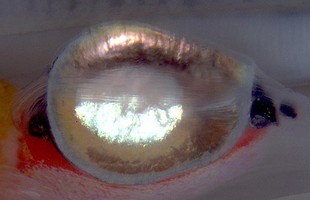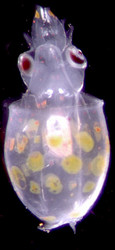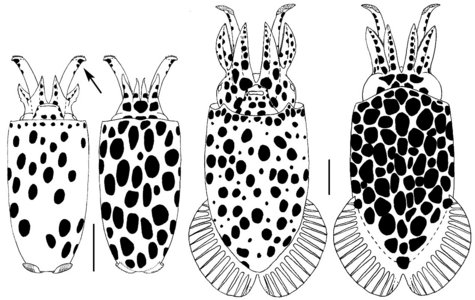Chtenopterygidae
Chtenopteryx
Combfin squid
Richard E. Young and Michael VecchioneThree species are presently recognized in the family but more are known to exist:
- Chtenopteryx canariensis Salcedo-Vargas and Guerrero-Kommritz 2000
- Chtenopteryx sepioloides Rancurel 1970
- Chtenopteryx sicula (Verany 1851)
Introduction
Members of this family are small, muscular, midwater squids that occupy tropical to subtropical waters probably at depths of 500-1000m during the day and near-surface waters at night. The posterior end of the mantle is broadly rounded. The fins are peculiar: they consist of muscular pillars (fin ribs) connected by thin membranes giving the appearance of a comb (hence the family name). The fin extends nearly the full length of the mantle.
A number of undescribed species are present in this genus. Little is known of the biology of any species.
Brief diagnosis:
A member of the Bathyteuthoidea ...
- with buccal connectives attaching to ventral border of arms IV.
- with long fins containing muscular ribs.
Characteristics
- Arms
- Dorsal six arms with suckers in six or more series at some point on arms.
- Buccal connectives attach to the ventral margins of arms IV.
- Tentacular club
- Suckers in 8 or more irregular series.
- Club ventrally expanded.
- Head
- Beaks: Descriptions can be found here: Lower beak; upper beak.
- Beaks: Descriptions can be found here: Lower beak; upper beak.
- Fins
- Membranes connect slender muscle bundles (fin ribs) to produce comb-like appearance.
- Fins attach to lateral walls of mantle.
- Fins extend nearly full length of mantle in subadults.
- Photophores
- Large oval photophore on viscera (except in C. canariensis.
- Large photogenetic patches on eyeball (except in C. canariensis).
- Viscera
- Females with an accessory nidamental glands.
Comments
Only a few species-level characters are known in Chtenopteryx. At present species are separated by (1) the maximum number of sucker series on the arms and tentacular clubs, (2) the presence/absence of photophores, (3) the size of the visceral photophore and (4) the mantle width relative to the ML.


Figure. Photograph of the visceral photophore of Chtenopteryx sp., off Hawaii by R. E. Young. The visceral photophore present in some species is constructed somewhat like a car headlight with double reflectors. A silver central reflector bounces bioluminescent light back into the photophore and onto the larger basal reflector which directs the light out of the photophore. The red tissue beneath the photophore is the digestive gland. The intestine is transparent and can barely be seen passing over the surface of the photophore. In the title photograph above, the visceral photophore is visible through the transparent mantle.
Nomenclature
Many authors have spelled the genus name for this taxon "Ctenopteryx." However, Bello and Giannuzzi-Savelli (1993) documented that Appellof's original spelling (1890) was "Chtenopteryx." The spelling was changed by Joubin (1900) and this change was solidified as an emendation by Pfeffer (1900) who decided that the original spelling was in error because Appellof derived the generic name from the Greek words for "comb" and "wing." In addition to pointing out that Pfeffer's emendation was unjustified, Bello and Giannuzzi-Savelli (1993) noted that Guerra (1992) had found that the Pfeffer/Joubin spelling is a junior homonym of Ctenopteryx Flach, 1889, a coleopteran subgenus. Therefore, although Ctenopteryx may seem superficially to be the appropriate spelling for the squid genus, the actual correct spelling is Appellof's original. Bello and Giannuzzi-Savelli (1993) further petitioned the International Commission on Zoological Nomenclature (ICZN) to place the name Chtenopterygidae Grimpe, 1922 on the Official List of Family-Group Names in Zoology and to place the name Ctenopterygidae Grimpe, 1922 on the Official List of Rejected and Invalid Family-Group Names in Zoology as an incorrect original spelling. These recommendations were accepted in ICZN Opinion 1793 (ICZN, 1995).
A list of all nominal genera and species in the Chtenopterygidae can be found here. The list includes the current status and type species of all genera, and the current status, type repository and type locality of all species and all pertinent references.
Life History
Early paralarvae of Chtenopteryx spp. have distinctive tentacular clubs: Each club has a disc-shaped oral surface that is covered with suckers. Presumably some unusual, but unknown, function is associated with the odd shape of this club.


Figure. Left - Oral view of the club of a 2.9 mm paralarva of Chtenopteryx sp. from the central North Atlantic. Scanning electron micrograph by Johnas Wright, provided by M. Vecchione. Right - Ventral view of a paralarva of Chtenopteryx sp., ca. 2-3 mm ML, off Hawaii. The disc-like clubs appear white in the photograph and face one another. This is the same species as illustrated below. Photograph by R. Young.
Paralarvae of two species of Chtenopteryx have been recognized in Hawaiian waters that differ in the chromatophore pattern on the distal end of the club. The more common form is illustrated below. Note that the fin ribs can just be detected in the smaller paralarva but the characteristic fins, although short, are clearly apparent in the larger paralarva. A distinctive feature of this species is the arrangement of chromatophores on the distal, aboral surface of the tentacle (arrow in illustration below).



Figure. Left - The thumbnail shows relative sizes of the two paralarvae. Right - Dorsal and ventral views of two sizes of paralarvae of Chtenopteryx sp. from Hawaiian waters. Left - 3.2 mm ML paralarva. Right - 5.4 mm ML paralarva. Drawings by R. Young. Scale bar is 1 mm.
Behavior
Males of some species possess a large photophore that lies within the shell sac. Chtenopteryx sp. in a shipboard aquarium has been observed to produce a brilliant luminescent flash but the source of the flash could not be determined (pers. obs.). This squid has been observed, in an aquarium, to adjust the intensity of light emited from its visceral photophore in response to changes in an overhead light (pers. obs.). This behavior is consistent with counterillumination (concealment via matching the downwelling light with bioluminescence) but the animal, in a horizontal attitude, did not conceal itself effectively as the head and posterior third of the body were relatively dark against the overhead light (ie, these regions cast shadows).
Distribution
Vertical distribution
In Hawaiian waters relatively few captures were made during the daytime but they suggest that Chtenopteryx "sicula" occupies depths from about 600-1000 m while at night it migrates mostly into the upper 200m (Young, 1978).

Figure. Vertical distribution of C. "sicula" in Hawaiian waters. Captures were made with both open and opening/closing trawls. Bars- fishing depth-range of opening/closing trawl. Circle - Modal fishing depth for either trawl. Square - Middepth of tow while fishing when no modal fishing depth was apparent. Blue-filled circles - Night captures. Yellow-filled circles - Day captures. Chart modified from Young (1978).
Geographical distribution
Species of Chtenopteryx are found throughout the tropical and subtropical waters of the world's oceans (Nesis, 1982).
References
Appellof, A. 1890. Teuthologische Beitrage. I. Chtenopteryx n.g., Veranya sicula Krohn. Calliteuthis Verrill. Bergens Museums Aarsberetning. 1889(33):1-34.
Bello, G. and R. Giannuzzi-Savelli. 1993. Case 2874. Chtenopteryx Appellof, 1890 (Mollusca, Cephalopoda): proposed confirmation as the correct original spelling. Bulletin of Zoological Nomenclature. 50(4):270-272.
Guerra, A. 1992. Mollusca, Cephalopoda. Fauna Iberica, Vol. 1 327 pp. Museo Nacional de Ciencias Naturales, CSIS, Madrid.
ICZN. 1995. OPINION 1793. Chtenopteryx Appellof, 1890 (Mollusca, Cephalopoda):confirmed as the correct original spelling. Bulletin of Zoological Nomenclature.52(1):96-97.
Joubin, L. 1900. Cephalopodes provenant des campagnes de la Princesse-Alice (1891-1897). Resultats des Campagnes Scientifiques accomplies sur son yacht par Albert Ier Prince Souverain de Monaco. 17:1-135.
Nesis, K. N. 1982. Abridged key to the cephalopod mollusks of the world's ocean. 385+ii pp. Light and Food Industry Publishing House, Moscow. (In Russian.). Translated into English by B. S. Levitov, ed. by L. A. Burgess (1987), Cephalopods of the world. T. F. H. Publications, Neptune City, NJ, 351pp.
Okutani, T. 1974. Epipelagic decapod cephalopods collected by micronekton tows during the EASTROPAC expeditions, 1967-1968 (systematic part). Bull. Tokai Reg. Fish. Res. Lab., 80: 29-118.
Pfeffer, G. 1900. Synopsis der oegopsiden Cephalopoden. Mitteilungen aus dem Naturhistorischen Museum in Hamburg. 17:145-198.
Title Illustrations

| Scientific Name | Chtenopteryx sp. |
|---|---|
| Location | Off Hawaii |
| Comments | The visceral and ocular photophore are visible through the transparent mantle and head muscles. |
| View | ventral |
| Image Use |
 This media file is licensed under the Creative Commons Attribution-NonCommercial License - Version 3.0. This media file is licensed under the Creative Commons Attribution-NonCommercial License - Version 3.0.
|
| Copyright |
© 1996

|
| Scientific Name | Chtenopteryx sp. |
|---|---|
| Location | eastern Tropical Pacific |
| Reference | modified from Okutani, T. 1974. Epipelagic decapod cephalopods collected by micronekton tows during the EASTROPAC expeditions, 1967-1968 (systematic part). Bull. Tokai Reg. Fish. Res. Lab. 80:29-118. |
| View | lateral |
| Copyright | © T. Okutani |
About This Page

University of Hawaii, Honolulu, HI, USA

National Museum of Natural History, Washington, D. C. , USA
Page copyright © 2016
 Page: Tree of Life
Chtenopterygidae . Chtenopteryx . Combfin squid.
Authored by
Richard E. Young and Michael Vecchione.
The TEXT of this page is licensed under the
Creative Commons Attribution-NonCommercial License - Version 3.0. Note that images and other media
featured on this page are each governed by their own license, and they may or may not be available
for reuse. Click on an image or a media link to access the media data window, which provides the
relevant licensing information. For the general terms and conditions of ToL material reuse and
redistribution, please see the Tree of Life Copyright
Policies.
Page: Tree of Life
Chtenopterygidae . Chtenopteryx . Combfin squid.
Authored by
Richard E. Young and Michael Vecchione.
The TEXT of this page is licensed under the
Creative Commons Attribution-NonCommercial License - Version 3.0. Note that images and other media
featured on this page are each governed by their own license, and they may or may not be available
for reuse. Click on an image or a media link to access the media data window, which provides the
relevant licensing information. For the general terms and conditions of ToL material reuse and
redistribution, please see the Tree of Life Copyright
Policies.
- Content changed 15 August 2010
Citing this page:
Young, Richard E. and Michael Vecchione. 2010. Chtenopterygidae . Chtenopteryx . Combfin squid. Version 15 August 2010 (under construction). http://tolweb.org/Chtenopteryx/19430/2010.08.15 in The Tree of Life Web Project, http://tolweb.org/








 Go to quick links
Go to quick search
Go to navigation for this section of the ToL site
Go to detailed links for the ToL site
Go to quick links
Go to quick search
Go to navigation for this section of the ToL site
Go to detailed links for the ToL site